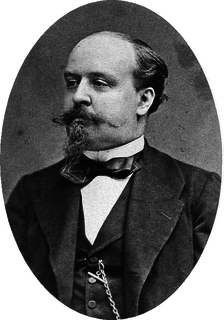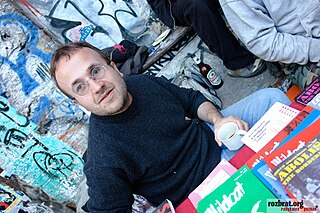
Stańczyk was a Polish court jester, the most famous in Polish history. He was employed by three Polish kings: Alexander, Sigismund the Old and Sigismund Augustus.

Michał Witkowski is a Polish novelist.

Juliusz Fortunat Kossak was a Polish historical painter and master illustrator who specialized in battle scenes, military portraits and horses. He was the progenitor of an artistic family that spanned four generations, father of painter Wojciech Kossak and grandfather of painter Jerzy Kossak.

Henryk Zieliński was a Polish historian and professor at the University of Wrocław.

The Bystrzyckie Mountains are a mountain range in Poland, part of the Central Sudetes.

Józef Jan Gosławski was a Polish sculptor and medallic artist. He was a designer of coins, monuments and medals. Laureate of many artistic competitions; decorated with the Silver Cross of Merit.

Wydawnictwo Literackie is a Kraków-based Polish publishing house, which has been referred to as one of Poland's "most respected".

Ewa Mazierska is a reader in Contemporary Cinema, in the Department of Humanities of the University of Central Lancashire. Her publications include numerous articles in Polish and English and monographs on two major modern filmmakers: Roman Polanski and Nanni Moretti. She also co-edited Relocating Britishness.
Tomasz Różycki is a Polish poet and translator. He studied Romance Languages at the Jagiellonian University in Kraków, and taught French at the Foreign Languages Teaching College in Opole. In addition to his teaching, he translated and published Stéphane Mallarmé's "Un coup de dés jamais n'abolira le hasard" in 2005, and continues to translate from French for publication.

Piotr Waglowski, known online as VaGla, is a Polish lawyer, poet, publicist and webmaster, open government activist, researcher of communication processes in the paradigm of social constructionism.

Rafał Górski was a Polish historian, writer, anarchist, trade union and housing activist.
Anna Ziaja is a Polish contemporary painter and print maker.

Małgorzata Dawidek Gryglicka is a Polish visual artist, writer and art historian. She lives in the UK. Dawidek came onto the Polish art scene in the early 2000s.

Magda Bielesz – painter, author of installations, objects, drawings, videos.
Jacek Baluch was a Polish scholar, writer, poet, translator and politician.

Prince Roman Fedorovich Sanguszko was a soldier and statesman of the Grand Duchy of Lithuania. He served as governor (voivode) of Bracław and was hetman of Lithuania from 1567 until his death. He fought at the Battle of Ula in 1564 and belonged to the nesuhoizhskoy branch of the House of Sanguszko.

Piotr Antoni Steinkeller was a Polish entrepreneur, banker and pioneering industrialist. He was known as the "King of Zinc" and opened the London Zinc Works in Hoxton in 1837.

Mieczysław Jan Gębarowicz (1893–1984) was a Polish art historian, soldier, dissident, museum director and custodian of cultural heritage.

Katarzyna Karpowicz is a Polish contemporary painter.
















